Significant Results From Diamond Drilling at Belltopper, Victoria

HIGHLIGHTS
|
Novo Executive Co-Chairman and Acting CEO Mike Spreadborough said.
“It is exciting to see promising results in the Belltopper drill results and identifying new gold reefs. Our team is focussed on determining the best way forward following the results received.
Our exploration activity across key assets continues to deliver exciting results and importantly, we are well-funded to continue our strong exploration program throughout 2024.”
VANCOUVER, British Columbia, June 03, 2024 (GLOBE NEWSWIRE) -- Novo Resources Corp. (Novo or the Company) (ASX: NVO) (TSX: NVO) (OTCQX: NSRPF) is pleased to report significant assays received from a six-hole (2,529 m) diamond drilling program completed at the Belltopper Gold Project (“Belltopper”) in Victoria (Figure 1).
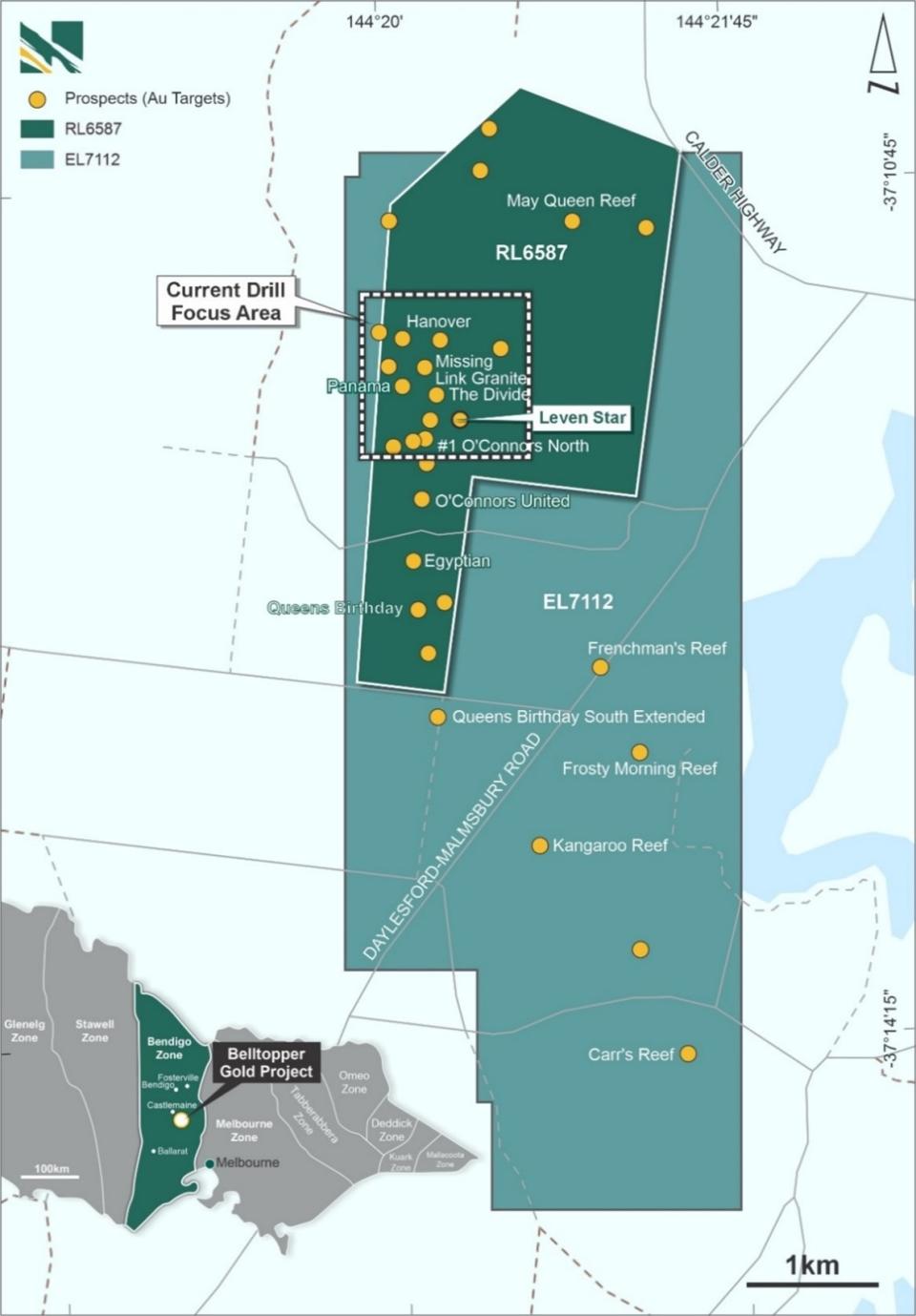
Figure 1: The Belltopper Gold Project location map with focus area for recent completed drilling.
SUMMARY
Recently completed drilling at Belltopper has delivered multiple new significant gold intercepts across a wide range of targets and includes the discovery of two new independent reefs with significant strike potential.
Highlights include:
2 m @ 15.18 g/t Au from 9 m in BTD004.
4.25 m @ 5.88 g/t Au from 274.75 m (inc. 2 m @ 11.15 g/t Au from 277 m) in BTD001.
12.26 m @ 1.45 g/t Au from 185 m (inc. 4.6 m @ 2.64 g/t Au from 185 m) in BTD005.
5.6 m @ 3.14 g/t Au from 219.8 m (inc. 3.04 m @ 4.97 g/t Au from 222.36 m) in BTD001.
7 m @ 1.88 g/t Au from 179 m (inc. 3.19 m @ 3.42 g/t Au from 182.81 m) in BTD006.
19.15 m @ 0.68 g/t Au from 216 m (inc. 1.45 m @ 1.82 g/t Au from 233.7 m) in BTD002.
The mineralisation presented in the body of this news release is not necessarily representative of mineralisation throughout the Belltopper Gold Project. Intercepts are expressed as down-hole intersections and should not be presumed to represent true widths, which vary from hole to hole and between reefs (refer JORC Table 1).
Significant gold results span a range of mineralisation styles; including oblique to stratigraphy high-grade shear or fault related mineralisation analogous to that at Costerfield or Stawell mines; layer-parallel laminated gold-bearing quartz, quartz breccia, and west-dipping mineralised faults analogous to high-grade Victorian deposits such as at Fosterville mine; and broad, low-grade mineralisation associated with the anticline saddle reef-style that has contributed so significantly to the historical gold endowment of the nearby Bendigo and Castlemaine goldfields.
The recent drilling continues momentum garnered from current exploration efforts and the 2021 - 2022 diamond program which discovered and delineated a gold-bearing felsic porphyry with clear IRG characteristics (confirming a new but hypothesised mineralisation style in the region); in addition to highlighting several underexplored, kilometre-scale, high-grade gold reefs with emerging shoot potential, that have in many cases only been tested by a handful of scout or reconnaissance holes at best.
The diamond drilling program was executed with a strong focus on safety, environment, and community engagement with no incidents. All drill sites used during the program have been rehabilitated.
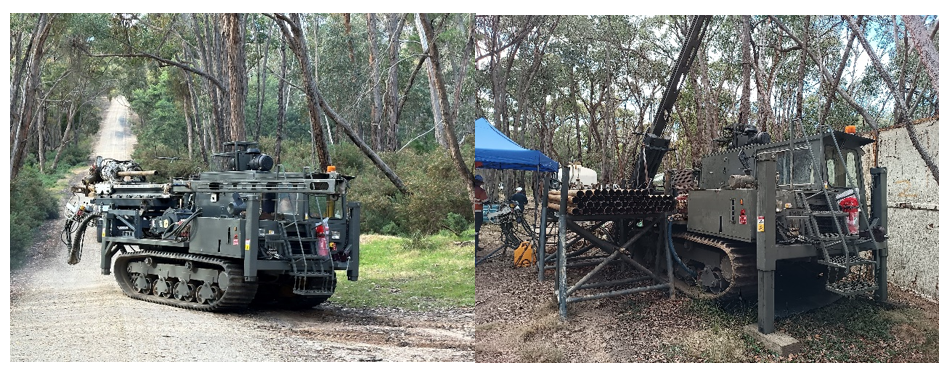
Photos of the diamond drill rig used in the program and a typical drill site.
PREVIOUS RECENT EXPLORATION
Previous (2021 – 2022) drilling at Belltopper returned significant results from underexplored historic gold reefs, including: the Missing Link, O’Connor’s, Queens Birthday, Panama, and Never Despair reefs; in addition to the more advance-drilled Leven Star Reef, with a current reported inferred resource of 0.82 Mt @ 3.95 g/t Au for 104 koz AU (JORC 2012)1.
Previously reported2 highlight results included:
14 m @ 6.1 g/t Au from 120 m (MD16, Leven Star Reef).
10 m @ 4.9 g/t Au from 173 m (MD16, Leven Star Reef).
8.1 m @ 5.79 g/t Au from 131.9 m (MD21, Leven Star Reef).
6.2 m @ 3.92 g/t Au from 144.6 m (MD21, Leven Star Reef).
7.8 m @ 3.6 g/t Au from 32.2 m (MD13, Leven Star Reef).
3.1 m @ 9.27 g/t Au from 400.9 m (MD20 Queens Birthday Reef).
9.1 m @ 2.4 g/t Au from 65.4 m (MD14 Leven Star / Missing Link intersection)
9 m @ 1.1 g/t Au from 257 m (MD19 O’Connor’s Reef)
Drill holes MD17 and MD22 from the 2021 - 2022 program additionally confirmed the sub-surface potential of a gold-bearing porphyritic felsic intrusive discovered and mapped in outcrop with IRG-characteristics (“the Missing Link Granite”). Previously reported3 results testing the gold-bearing felsic porphyry returned:
79.9 m @ 0.26 g/t Au from 197 m (MD17).
45 m @ 0.23 g/t Au from 134 m (MD22).
23 m at 0.46 g/t Au from 18 m (DDHMA3, historic hole infill assayed in 2022).
The 2021 – 2022 drilling demonstrated the potential for high-grade mineralisation on multiple prospective epizonal gold-reefs, in addition to confirming the potential for intrusive hosted or IRG mineralisation at Belltopper. The current program aimed to further test the potential at Belltopper to host occurrences of very-high-grade, world-class, epizonal-style mineralisation.
RESULTS AND INTERPRETATION FROM THE CURRENT PROGRAM
The six-hole (2,529 m) diamond drilling program (Figure 2) was completed at Belltopper between December 2023 and March 2024 with all results recently returned (including required, additional infill assays). The drill program was designed to test various structural, geochemical, and geophysical (IP) targets across a range of geological settings within the 22 sq km Belltopper tenements.
Drill hole BTD002 tested one of two high-order IP chargeability anomalies across a key anticline corridor and a potential SE extension of the historic NE-dipping Hanover Reef. A broad zone of mineralisation returning 19.5 m @ 0.68 g/t Au from 216 m in line with the modelled position for the Hanover Reef and nearby position of historic workings strongly suggests this reef was successfully intersected. presents all (+2-gram x metre) significant intersections returned from the six-hole program. Refer to Appendices for a full listing of all anomalous (> 0.3 gram x metre) intersections.
Drill hole BTD001 returned significant results on the Leven Star Reef within an emerging high-grade zone, reporting 4.25 m @ 5.88 g/t Au from 274.75 m (includes 2 m @ 11.15 g/t Au from 277 m) (Figure 3); 5.6 m @ 3.14 g/t Au from 219.8 m (Figure 4); and 1.94 m @ 2.37 g/t Au from 230 m (Drill hole BTD002 tested one of two high-order IP chargeability anomalies across a key anticline corridor and a potential SE extension of the historic NE-dipping Hanover Reef. A broad zone of mineralisation returning 19.5 m @ 0.68 g/t Au from 216 m in line with the modelled position for the Hanover Reef and nearby position of historic workings strongly suggests this reef was successfully intersected. ). Drilling extended mineralisation up to 120 m down-dip of previously reported results and confirm a structural repeat (or overlap) of a high-grade segment of the Leven Star Reef in this zone (Figure 5). The Reef remains open at depth.
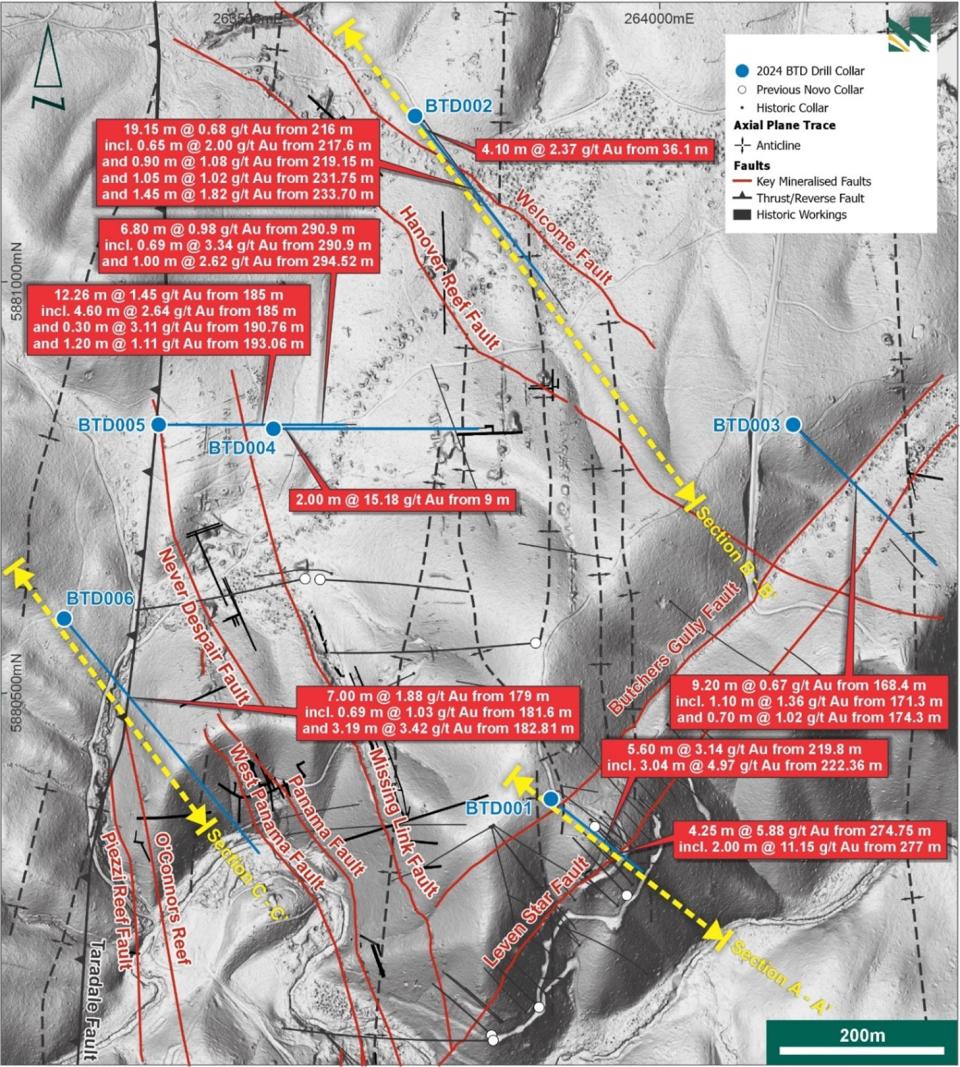
Figure 2: Collar location map and drill azimuth for six recently completed diamond drill holes with key significant intervals highlighted. Projected mining infrastructure in addition to key target mineralised reefs (red lines) also depicted.
Table 1: Significant (+ 2-gram x metre) intersections reported for recent drilling at Belltopper (holes BTD001 through BTD006). Intercepts calculated with 0.3 g/t Au cut-off and 2 m internal dilution. High grade included intercepts calculated with 1.0 g/t Au and no internal dilution. All significant intersections from recent BTD series Belltopper drilling reported.
Drill Hole | Including | From (m) | To (m) | Interval (m) ^ | Au (g/t) | Au g*m ^^ | Intersection |
BTD001 |
| 219.80 | 225.40 | 5.60 | 3.14 | 17.6 | 5.60 m @ 3.14 g/t Au from 219.8 m |
BTD001 | inc. | 222.36 | 225.40 | 3.04 | 4.97 | 15.1 | 3.04 m @ 4.97 g/t Au from 222.36 m |
BTD001 |
| 230.00 | 231.94 | 1.94 | 2.37 | 4.6 | 1.94 m @ 2.37 g/t Au from 230 m |
BTD001 |
| 241.30 | 244.30 | 3.00 | 1.16 | 3.5 | 3.00 m @ 1.16 g/t Au from 241.3 m |
BTD001 |
| 274.75 | 279.00 | 4.25 | 5.88 | 25.0 | 4.25 m @ 5.88 g/t Au from 274.75 m |
BTD001 | inc. | 277.00 | 279.00 | 2.00 | 11.15 | 22.3 | 2.00 m @ 11.15 g/t Au from 277 m |
BTD002 |
| 36.10 | 40.20 | 4.10 | 2.37 | 9.7 | 4.10 m @ 2.37 g/t Au from 36.1 m |
BTD002 |
| 216.00 | 235.15 | 19.15 | 0.68 | 13.0 | 19.15 m @ 0.68 g/t Au from 216 m |
BTD002 | inc. | 233.70 | 235.15 | 1.45 | 1.82 | 2.6 | 1.45 m @ 1.82 g/t Au from 233.7 m |
BTD003 |
| 168.40 | 177.60 | 9.20 | 0.67 | 6.2 | 9.20 m @ 0.67 g/t Au from 168.4 m |
BTD003 |
| 318.41 | 321.41 | 3.00 | 1.00 | 3.0 | 3.00 m @ 1.00 g/t Au from 318.41 m |
BTD004 |
| 9.00 | 11.00 | 2.00 | 15.18 | 30.4 | 2.00 m @ 15.18 g/t Au from 9 m |
BTD004 |
| 90.58 | 92.00 | 1.42 | 1.61 | 2.3 | 1.42 m @ 1.61 g/t Au from 90.58 m |
BTD004 |
| 136.87 | 138.67 | 1.80 | 1.29 | 2.3 | 1.80 m @ 1.29 g/t Au from 136.87 m |
BTD005 |
| 1.10 | 5.90 | 4.80 | 0.78 | 3.8 | 4.80 m @ 0.78 g/t Au from 1.1 m |
BTD005 |
| 145.33 | 147.20 | 1.87 | 1.17 | 2.2 | 1.87 m @ 1.17 g/t Au from 145.33 m |
BTD005 |
| 164.11 | 167.28 | 3.17 | 1.07 | 3.4 | 3.17 m @ 1.07 g/t Au from 164.11 m |
BTD005 | inc. | 165.29 | 166.29 | 1.00 | 2.08 | 2.1 | 1.00 m @ 2.08 g/t Au from 165.29 m |
BTD005 |
| 185.00 | 197.26 | 12.26 | 1.45 | 17.7 | 12.26 m @ 1.45 g/t Au from 185 m |
BTD005 | inc. | 185.00 | 189.60 | 4.60 | 2.64 | 12.1 | 4.60 m @ 2.64 g/t Au from 185 m |
BTD005 |
| 290.90 | 297.70 | 6.80 | 0.98 | 6.7 | 6.80 m @ 0.98 g/t Au from 290.9 m |
BTD005 | inc. | 290.90 | 291.59 | 0.69 | 3.34 | 2.3 | 0.69 m @ 3.34 g/t Au from 290.9 m |
BTD005 | inc. | 294.52 | 295.52 | 1.00 | 2.62 | 2.6 | 1.00 m @ 2.62 g/t Au from 294.52 m |
BTD006 |
| 163.38 | 165.06 | 1.68 | 2.18 | 3.7 | 1.68 m @ 2.18 g/t Au from 163.38 m |
BTD006 |
| 179.00 | 186.00 | 7.00 | 1.88 | 13.1 | 7.00 m @ 1.88 g/t Au from 179 m |
BTD006 | inc. | 182.81 | 186.00 | 3.19 | 3.42 | 10.9 | 3.19 m @ 3.42 g/t Au from 182.81 m |
BTD006 |
| 296.42 | 298.18 | 1.76 | 1.17 | 2.1 | 1.76 m @ 1.17 g/t Au from 296.42 m |
^ All width and intercepts are expressed as metres downhole rather than true width. Most intersections tabulated above will have an oblique component. Refer to drill cross sections. Calculated as length weighted averages. ^^ Au g/t multiplied by metres.
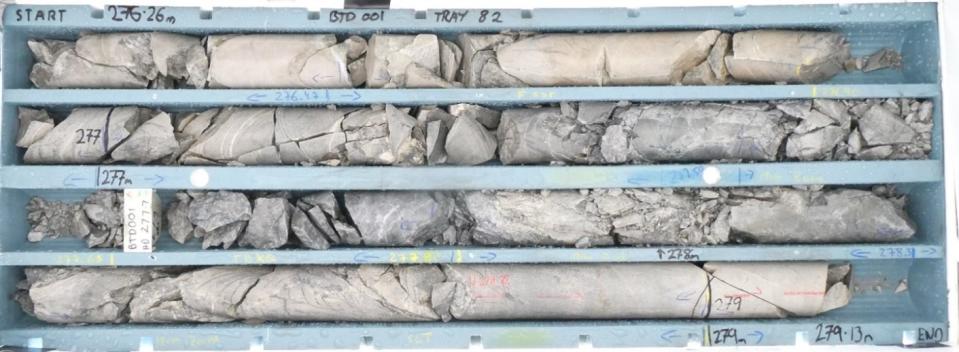
Figure 3: BTD001 from 276.26 m – 279.13 m. Structural repeat (or overlap) of Leven Star Reef at depth returning 4.25 m @ 5.88 g/t Au from 274.75 m (including 2 m @ 11.15 g/t Au from 277 m).
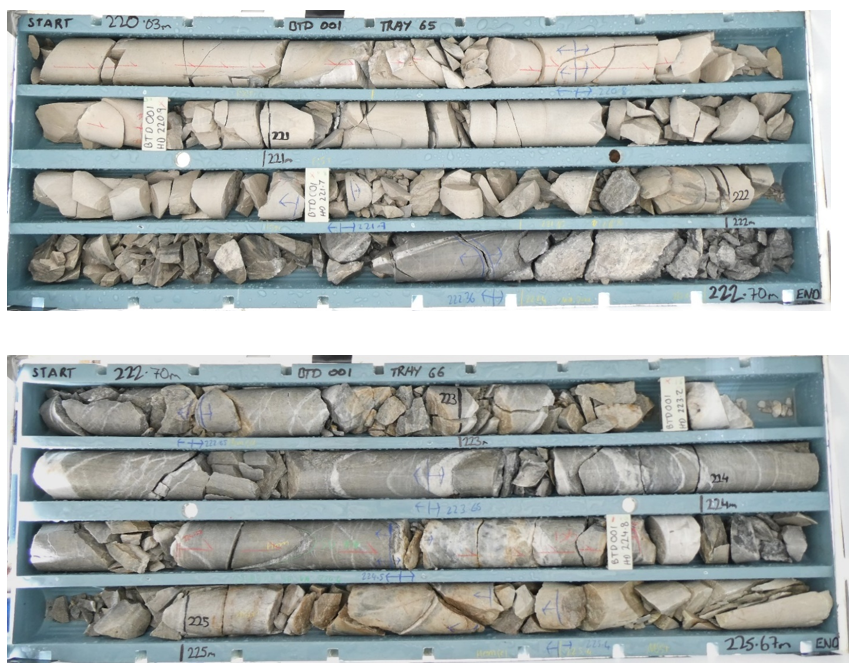
Figure 4: BTD001 from 220.03 m – 225.67 m. Leven Star hanging wall splay structure returning
5.60 m @ 3.14 g/t Au from 219.8 m (including 3.04 m @ 4.97 g/t Au from 222.36 m).
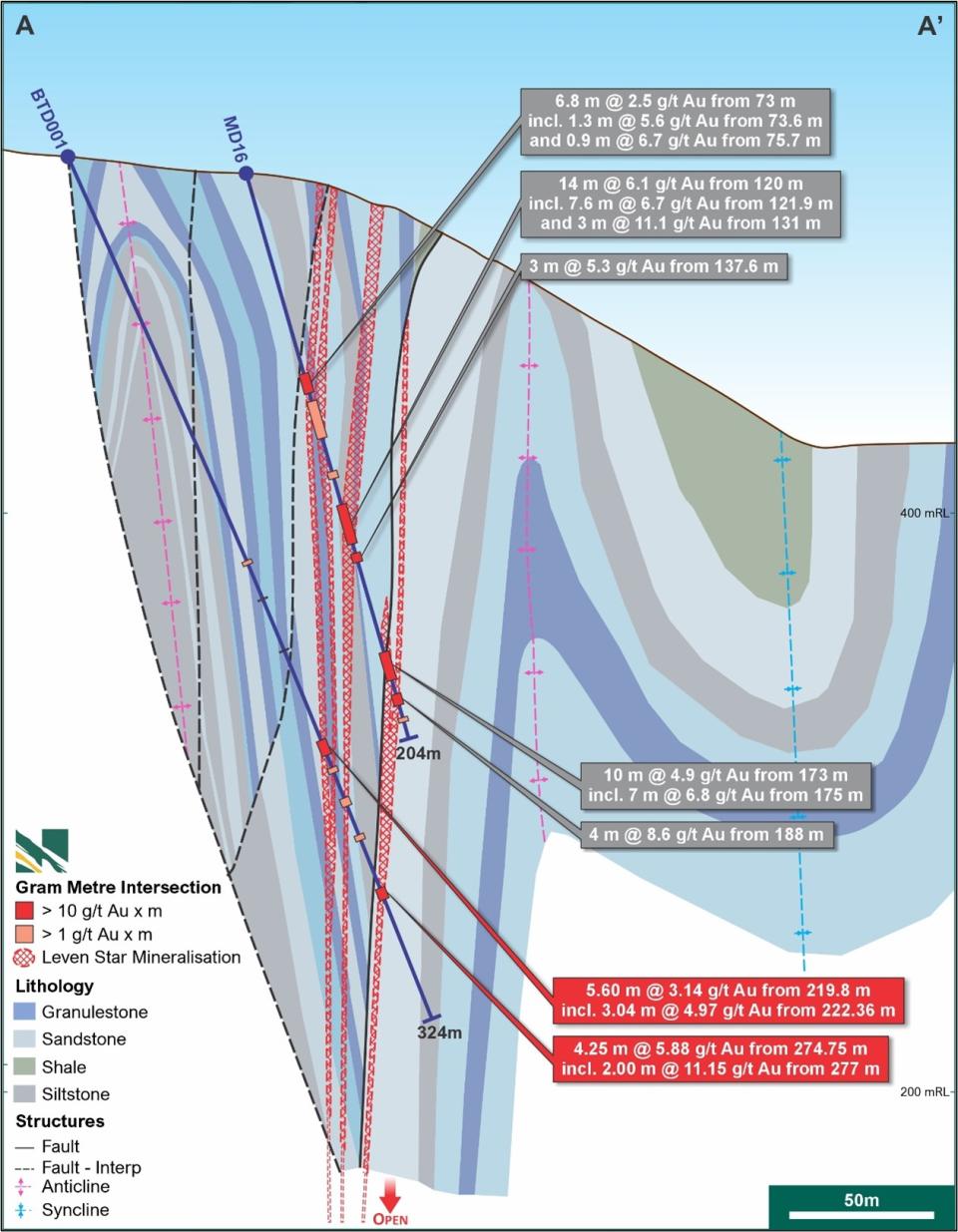
Figure 5: Drill holes BTD001 and MD164 on section with updated geological interpretation. Of note are the lowermost modelled high-grade zones in MD16 and BTD001 which are interpreted to represent fault repetition (i.e. structural thickening) of the Leven Star mineralisation. The Leven Star is lightly drilled at this RL, remains open at depth, and requires further drilling to evaluate mineralisation potential, and the extent of the local structurally overlapping portion of the reef in this developing high grade zone.
Drill hole BTD002 tested one of two high-order IP chargeability anomalies across a key anticline corridor and a potential SE extension of the historic NE-dipping Hanover Reef. A broad zone of mineralisation returning 19.5 m @ 0.68 g/t Au from 216 m in line with the modelled position for the Hanover Reef and nearby position of historic workings strongly suggests this reef was successfully intersected.
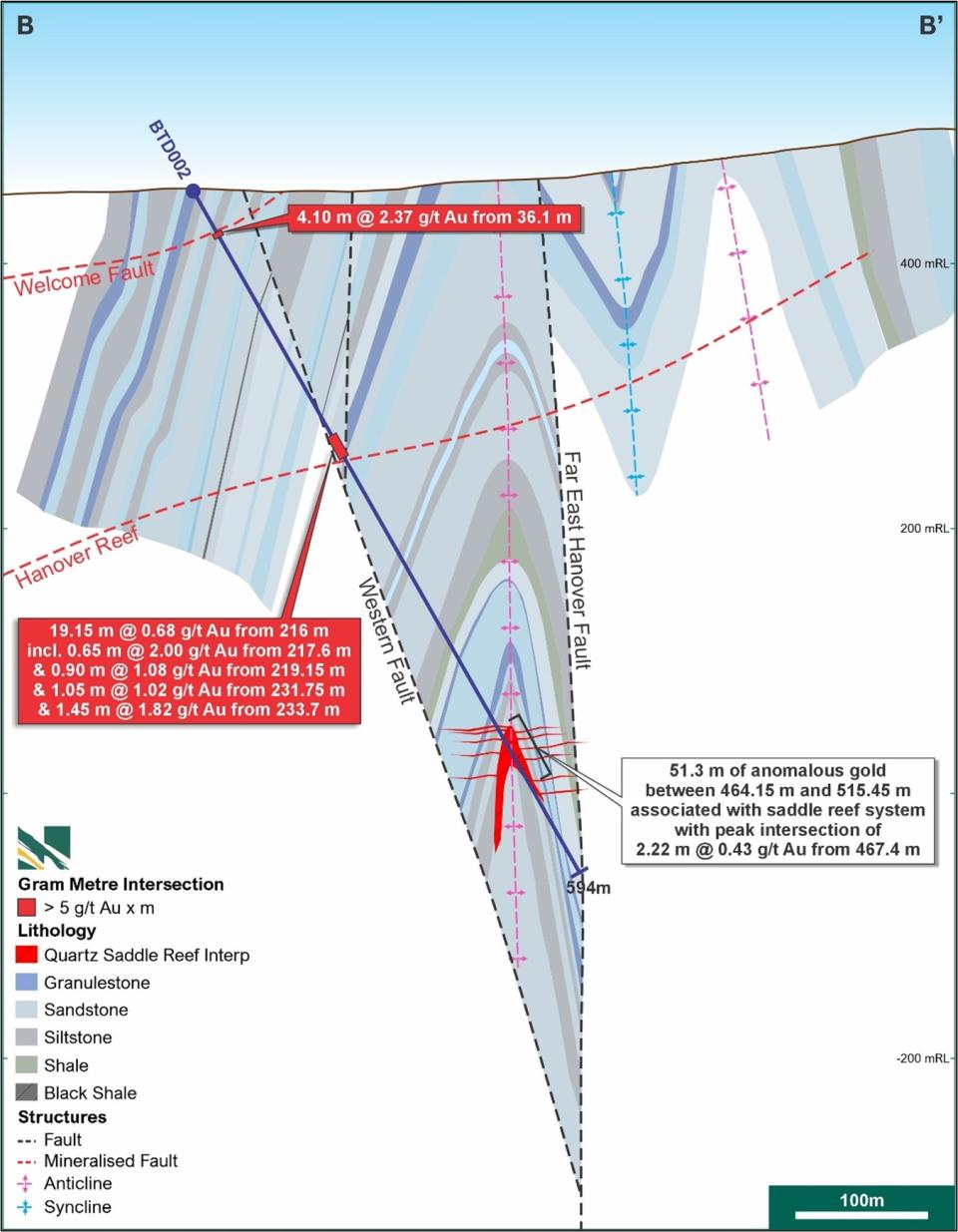
Figure 6: BTD002 on section with significant (>5-gram x metre) intersections. The Welcome Fault represents a newly discovered NE-dipping gold reef that is parallel to, and in the hanging-wall of, the targeted Hanover Reef. The anticline is occupied by a significant, gold anomalous quartz saddle reef as intersected by BTD002 (peak intersection of 2.22 m @ 0.43 g/t Au from 467.4 m).
An additional parallel reef “the Welcome Fault,” was discovered in the hanging-wall position of the Hanover Reef and returned 4.1 m @ 2.37 g/t Au from 36.1 m (Figure 7). Both the Hanover Reef and Welcome Fault are relatively closely spaced, parallel targets with a potential strike length exceeding 800 m based on historic workings and mapping.
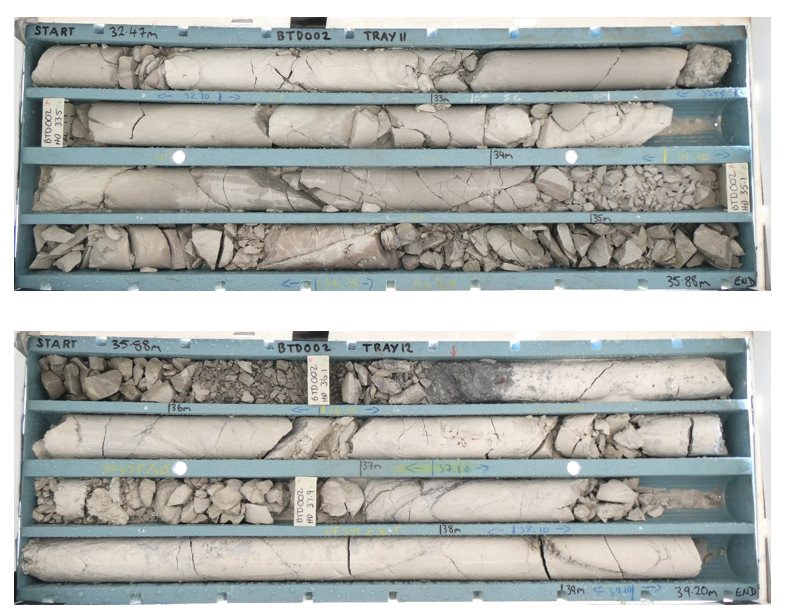
Figure 7: BTD002 from 32.47 m – 39.20 m across the Welcome Fault returning 4.10 m @ 2.37 g/t Au from 36.1 m. This zone is characterised by abundant blebs and veinlets of sulphide (pyrite + arsenopyrite) up to 15% locally. Pervasive sericite alteration with kaolinite gives the altered siltstone and fine sandstone a characteristic bleached appearance.
Up to 15% arsenopyrite and pyrite were logged in the Welcome Fault near surface; and up to 5% in the underlying Hanover Fault indicating a potential source for the IP Chargeability anomaly (Figure 8). This zone is interpreted to trend NW and parallel to both structures and remains mostly untested. BTD002 is the first hole drilled into this high priority, developing NW-trending structural and IP target corridor.
An interpreted saddle reef characterised by a wide intersection of quartz veining was also encountered between 464 – 515 m in BTD002 across an anticline (Figure 6). Anomalous gold averaging >0.1 g/t Au; with a peak intercept of 2.22 m @ 0.43 g/t Au from 467.4 m demonstrate gold fertility and highlight the anticlines as key target features with the potential to host multiple mineralisation styles.
A potential NE extension to the Leven Star and a parallel structure expressed at surface by a historically exploited alluvial gold channel known as Butchers Gully was targeted in BTD003. Two distinct, narrow (< 1 m) sulphide-breccias within wider (> 5 m) zones of intense sericite and clay alteration were encountered at 107.05 m and 132.6 m respectively, with the latter returning a narrow result of 0.3 m @ 3.71 g/t Au from 132.6 m, and the former returning an anomalous result of 0.90 m @ 0.37 g/t Au from 107 m; providing evidence that the Butchers Gully target is mineralised at depth. An intersection of 3.00 m @ 1.00 g/t Au from 318.41 m in BTD003 characterised by increased silica with disseminated chalcopyrite, arsenopyrite and pyrite is interpreted as a potential Leven Star Reef extension.
The second high-order chargeability anomaly was tested on section by holes BTD004 and BTD005 (Figure 8), in addition to several known and interpreted reef positions. Multiple gold occurrences were intersected across both holes (Drill hole BTD002 tested one of two high-order IP chargeability anomalies across a key anticline corridor and a potential SE extension of the historic NE-dipping Hanover Reef. A broad zone of mineralisation returning 19.5 m @ 0.68 g/t Au from 216 m in line with the modelled position for the Hanover Reef and nearby position of historic workings strongly suggests this reef was successfully intersected. ), with peak result of 2 m @ 15.18 g/t Au from 9 m associated with a thin limonitic tectonic breccia. This new high-grade intercept is flagged for follow up.
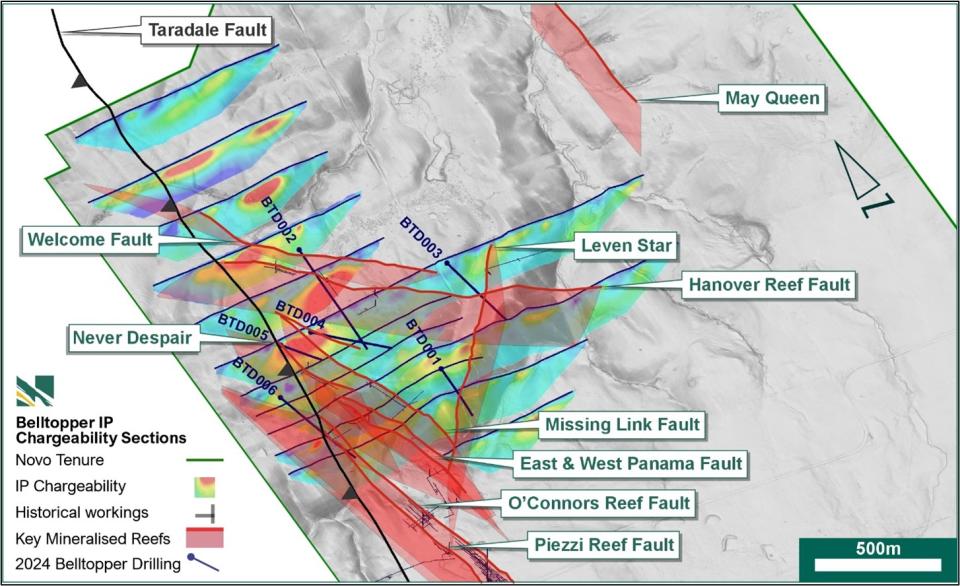
Figure 8: Oblique view of IP lines showing chargeability anomalies and key reefs tested as part of current program.
Drill hole BTD005 has intersected the Missing Link Reef, returning 12.26 m @ 1.45 g/t Au from 185 m (includes 4.6 m @ 2.64 g/t Au from 185 m) and extends this prospective reef an additional ~200 m to the north from previous drilling (MD18)5. BTD005 is drilled oblique to the Missing Link Reef and is not considered true width.
Drill hole BTD006 (Figure 9) targets a strong geochemical anomaly immediately adjacent the Taradale Fault. Several mineralised structures were intersected, with the most significant returning 7 m @ 1.88 g/t Au from 179 m (includes 3.19 m @ 3.42 g/t Au from 182.81 m). This intersection likely represents an extension to the Piezzi-Stackyard Reef that was historically mined and explored adjacent the larger O’Connor’s reef. The O’Connor’s Reef and Piezzi-Stackyard Reef represent a priority target that extends over a 1.8 km strike and is open in all directions. Only three diamond holes drilled to date test these reefs.
BTD006 has also demonstrated that the regionally significant Taradale Fault and associated splays are mineralised, albeit to lower levels, returning a peak result of 1.42 m @ 1.23 g/t Au from 150.43 m along the main Taradale structure.
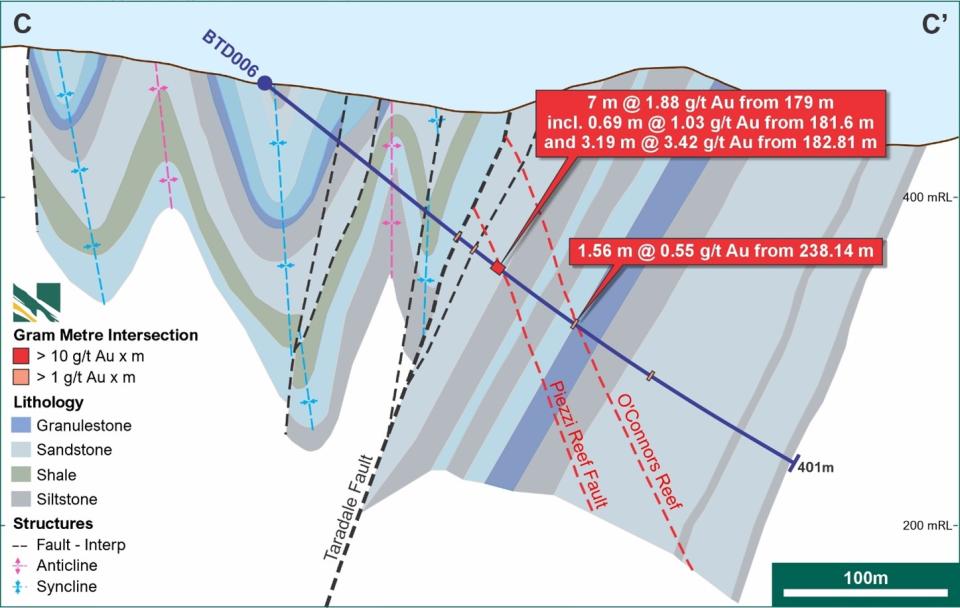
Figure 9: BTD006 on section testing the regionally significant Taradale Fault and associated splay structures. A significant (>5-gram x metre) intersection along the east-dipping Piezzi Reef Fault returned 7 m @ 1.88 g/t Au and anomalous gold is present across the O’Connors Reef. Both the Piezzi and O’Connor’s reefs are interpreted as “Blind Targets,” on this section, occurring in the footwall of the Taradale Fault and not daylighting at surface.
BELLTOPPER FORWARD PROGRAM
Work is currently focussed on reviewing and re-logging historic drill holes relevant to current targets at Belltopper. Several historic holes intersect known or modelled reef occurrences, but in many cases the reefs are either unsampled, partially sampled or niche-sampled only. Where these unsampled prospective reefs are confirmed, they are infill sampled as part of the current program. Assays from infill sampling of historic core are predominantly still outstanding.
Information from the historic core re-logging and infill sampling program forms an important component of a detailed review of the Leven Star mineral resource, which is currently underway.
An expanded spectral logging program on pulps from key historic and recent drill hole samples has also commenced. In conjunction with detailed multi-element data for the corresponding pulps, this will provide another critical layer to be integrated into the targeting model to help vector into the most prospective areas for high-grade mineralisation.
It is anticipated that the remaining data from the current historic core logging and sampling program, in addition to data and interpretation from the hyperspectral sampling program, will be fully integrated into the evolving 3D targeting model at Belltopper by Q3, 2024. At that point, planning for the next phase of drilling and further exploration activities can be executed.
Mapping and surface sampling is additionally planned to follow up significant new reef discoveries in drilling that warrant investigation at surface, in addition to expanding the exercise across priority areas that have yet to be mapped and sampled at Belltopper.
ANALYTICAL METHODOLOGY
Diamond Core
The diamond drill core was sampled by cutting the core in half longitudinally. Samples were cut to geological boundaries or to a preferred length of 1.0 m. The core was halved along the plane of orientation using a diamond saw and the upper half of the core dispatched for analysis and the lower half returned to the core tray in its original orientation. Sampling interval lengths range from 0.3 m up to 1.3 m. Core loss zones greater than or equal to 0.2 m are recorded. Sampling does not cross core loss zones of greater than or equal to 0.3 m. Depending on their relationship to potential mineralization, zones with core loss less than 0.3 m and greater than 0.1 m can terminate a sampling sequence or be included within a sample interval with the percentage of sample recovery recorded. Where core loss cannot be specifically attributed, the percentage of sample recovery is recorded.
All core samples were crushed and pulverised at ALS Limited in Adelaide, Australia (ALS CRU-21/PUL-23) and sub-sampled for fire assay and multi-element analysis at ALS Limited in Perth, Australia (ALS Au-AA26, ME-MS61).
Drill core duplicates are inserted at a rate of one sample every 25. To produce a duplicate sample, the whole core sample is first cut in half, with half of the core returned to the tray. The other half is then quartered with one quarter used as a primary sample and the other as the duplicate.
Blanks and standards are inserted at a rate of eight samples in 100, with three OREAS CRM standards (OREAS 232, OREAS 239, OREAS 264) and one blanks (OREAS C26d) systematically repeated.
No QAQC issues were detected. All relevant data was verified by a qualified person/competent person (as defined in National Instrument 43-101 Standards of Disclosure for Mineral Projects (“NI 43-101”) and the Australasian Code for Reporting of Exploration Results, Mineral Resources and Ore Reserves (JORC Code) respectively) by reviewing analytical procedures undertaken by ALS Limited.
Authorised for release by the Board of Directors.
CONTACT
Investors: | North American Queries: | Media: |
|
QP STATEMENT
Dr. Christopher Doyle (MAIG), is the qualified person, as defined under National Instrument 43-101 Standards of Disclosure for Mineral Projects, responsible for, and having reviewed and approved, the technical information contained in this news release. Dr. Doyle is Novo’s Exploration Manager – Victoria.
JORC COMPLIANCE STATEMENT
The information in this report that relates to new exploration results at the Belltopper Gold Project is based on information compiled by Dr. Christopher Doyle, who is a full-time employee of Novo Resources Corp. Dr. Christopher Doyle is a Competent Person who is a member of the Australian Institute of Geoscientists. Dr. Christopher Doyle has sufficient experience that is relevant to the style of mineralisation and the type of deposits under consideration and to the activity being undertaken to qualify as a Competent Person as defined in the 2012 Edition of the 'Australasian Code for Reporting of Exploration Results, Mineral Resources and Ore Reserves'. Dr. Christopher Doyle consents to the inclusion in the report of the matters based on her information in the form and context in which it appears.
The information in this news release in relation to previous exploration results at Leven Star and other prospects on the Belltopper Gold Project (Belltopper) is extracted from various news releases as referenced herein and Novo's Prospectus dated 2 August 2023 (which includes an Independent Geologist's Report at Annexure 1) that was released to ASX on 7 September 2023 and which is available to view on www.asx.com.au. The Company confirms that it is not aware of any new information or data that materially affects the information included in the original market announcement and confirms that the form and context in which the Competent Person's findings are presented have not been materially modified from the original market announcement.
FORWARD-LOOKING STATEMENTS
Some statements in this news release may contain “forward-looking statements” within the meaning of Canadian and Australian securities law and regulations. In this news release, such statements include but are not limited to planned exploration activities and the timing of such. These statements address future events and conditions and, as such, involve known and unknown risks, uncertainties and other factors which may cause the actual results, performance or achievements to be materially different from any future results, performance or achievements expressed or implied by the statements. Such factors include, without limitation, customary risks of the resource industry and the risk factors identified in Novo’s annual information form for the year ended December 31, 2023 (which is available under Novo’s profile on SEDAR+ at www.sedarplus.ca and at www.asx.com.au) in the Company’s prospectus dated 2 August 2023 which is available at www.asx.com.au. Forward-looking statements speak only as of the date those statements are made. Except as required by applicable law, Novo assumes no obligation to update or to publicly announce the results of any change to any forward-looking statement contained or incorporated by reference herein to reflect actual results, future events or developments, changes in assumptions or changes in other factors affecting the forward-looking statements. If Novo updates any forward-looking statement(s), no inference should be drawn that the Company will make additional updates with respect to those or other forward-looking statements.
ABOUT NOVO
Novo is an Australian based gold explorer listed on the ASX and the TSX focused on discovering standalone gold projects with > 1 Moz development potential. Novo is an innovative gold explorer with a significant land package covering approximately 7,000 square kilometres in the Pilbara region of Western Australia, along with the 22 square kilometre Belltopper project in the Bendigo Tectonic Zone of Victoria, Australia.
Novo’s vanguard Project is the Egina Gold Camp, where De Grey is farming-in at Becher and surrounding tenements through exploration expenditure of A$25 million within 4 years for a 50% interest. Significant gold mineralisation has also been identified at Nunyerry North, this area is part of the Croyden JV (Novo 70%: Creasy Group 30%).
With a dedicated and disciplined acquisition program in place to identify value accretive opportunities and via its exposure to non-core minerals and metals through joint partnerships, Novo is focused on building further value for shareholders.
APPENDIX 1: BELLTOPPER 2024 DRILL COLLARS
Hole ID | Hole Type | Depth (m) | Easting | Northing | RL AHD (m) | Lease ID | Collar Dip | Collar | Collar Azimuth (Mag) (°) |
BTD001 | DD | 323.7 | 263866.02 | 5880369.85 | 524.18 | RL006587 | -66 | 128.5 | 119.0 |
BTD002 | DD | 594 | 263701.31 | 5881202.77 | 457.18 | RL006587 | -60 | 145.1 | 135.6 |
BTD003 | DD | 389.7 | 264162.29 | 5880827.97 | 489.97 | RL006587 | -50.05 | 135.1 | 125.6 |
BTD004 | DD | 521 | 263530.06 | 5880820.71 | 471.69 | RL006587 | -45 | 90.2 | 80.7 |
BTD005 | DD | 299.9 | 263394.65 | 5880825.96 | 471.94 | RL006587 | -50 | 90.5 | 81.0 |
BTD006 | DD | 400.6 | 263263.53 | 5880606.13 | 470.22 | RL006587 | -37.88 | 144.5 | 135.0 |
All drill collars are reported in MGA94 Zone 55
APPENDIX 2: BELLTOPPER 2024 SIGNIFICANT INTERSECTIONS
Intercepts calculated with 0.3 g/t Au cut-off and 2 m internal dilution. High grade included intercepts calculated with 1.0 g/t Au and no internal dilution. All significant intersections from recent BTD series Belltopper drilling reported.
^ All width and intercepts are expressed as metres downhole rather than true width. Calculated as length weighted averages.
^^ Au g/t multiplied by metres.
Logged core loss treated as 0 g/t Au grade in all calculations. The gold assay of a primary sample from a duplicate pair will be used in all calculations. Any isolated gold intersections separated by internal dilution must independently be above the average cut-off grade when including the grades of the internal dilution.
Drill Hole | Including | From (m) | To (m) | Interval (m) ^ | Au (g/t) | Au g*m ^^ | Intersection |
BTD001 |
| 27.00 | 27.80 | 0.80 | 0.53 | 0.4 | 0.80 m @ 0.53 g/t Au from 27 m |
BTD001 |
| 54.30 | 55.30 | 1.00 | 0.95 | 1.0 | 1.00 m @ 0.95 g/t Au from 54.3 m |
BTD001 |
| 73.15 | 74.15 | 1.00 | 0.34 | 0.3 | 1.00 m @ 0.34 g/t Au from 73.15 m |
BTD001 |
| 80.45 | 80.80 | 0.35 | 0.37 | 0.1 | 0.35 m @ 0.37 g/t Au from 80.45 m |
BTD001 |
| 90.50 | 91.50 | 1.00 | 0.34 | 0.3 | 1.00 m @ 0.34 g/t Au from 90.5 m |
BTD001 |
| 95.61 | 95.95 | 0.34 | 0.62 | 0.2 | 0.34 m @ 0.62 g/t Au from 95.61 m |
BTD001 |
| 100.95 | 101.95 | 1.00 | 0.37 | 0.4 | 1.00 m @ 0.37 g/t Au from 100.95 m |
BTD001 |
| 119.18 | 119.80 | 0.62 | 0.87 | 0.5 | 0.62 m @ 0.87 g/t Au from 119.18 m |
BTD001 |
| 137.10 | 138.10 | 1.00 | 0.52 | 0.5 | 1.00 m @ 0.52 g/t Au from 137.1 m |
BTD001 |
| 146.50 | 147.50 | 1.00 | 0.70 | 0.7 | 1.00 m @ 0.70 g/t Au from 146.5 m |
BTD001 |
| 152.65 | 154.15 | 1.50 | 0.90 | 1.4 | 1.50 m @ 0.90 g/t Au from 152.65 m |
BTD001 |
| 166.85 | 167.30 | 0.45 | 3.38 | 1.5 | 0.45 m @ 3.38 g/t Au from 166.85 m |
BTD001 |
| 186.15 | 186.50 | 0.35 | 3.26 | 1.1 | 0.35 m @ 3.26 g/t Au from 186.15 m |
BTD001 |
| 189.50 | 190.50 | 1.00 | 0.47 | 0.5 | 1.00 m @ 0.47 g/t Au from 189.5 m |
BTD001 |
| 219.80 | 225.40 | 5.60 | 3.14 | 17.6 | 5.60 m @ 3.14 g/t Au from 219.8 m |
BTD001 | inc. | 222.36 | 225.40 | 3.04 | 4.97 | 15.1 | 3.04 m @ 4.97 g/t Au from 222.36 m |
BTD001 |
| 230.00 | 231.94 | 1.94 | 2.37 | 4.6 | 1.94 m @ 2.37 g/t Au from 230 m |
BTD001 |
| 238.50 | 239.30 | 0.80 | 0.35 | 0.3 | 0.80 m @ 0.35 g/t Au from 238.5 m |
BTD001 |
| 241.30 | 244.30 | 3.00 | 1.16 | 3.5 | 3.00 m @ 1.16 g/t Au from 241.3 m |
BTD001 |
| 246.30 | 247.30 | 1.00 | 0.79 | 0.8 | 1.00 m @ 0.79 g/t Au from 246.3 m |
BTD001 |
| 254.95 | 257.00 | 2.05 | 0.94 | 1.9 | 2.05 m @ 0.94 g/t Au from 254.95 m |
BTD001 |
| 274.75 | 279.00 | 4.25 | 5.88 | 25.0 | 4.25 m @ 5.88 g/t Au from 274.75 m |
BTD001 | inc. | 277.00 | 279.00 | 2.00 | 11.15 | 22.3 | 2.00 m @ 11.15 g/t Au from 277 m |
BTD002 |
| 36.10 | 40.20 | 4.10 | 2.37 | 9.7 | 4.10 m @ 2.37 g/t Au from 36.1 m |
BTD002 |
| 127.80 | 128.90 | 1.10 | 1.29 | 1.4 | 1.10 m @ 1.29 g/t Au from 127.8 m |
BTD002 |
| 197.35 | 199.00 | 1.65 | 0.36 | 0.6 | 1.65 m @ 0.36 g/t Au from 197.35 m |
BTD002 |
| 216.00 | 235.15 | 19.15 | 0.68 | 13.0 | 19.15 m @ 0.68 g/t Au from 216 m |
BTD002 | inc. | 217.60 | 218.25 | 0.65 | 2.00 | 1.3 | 0.65 m @ 2.00 g/t Au from 217.6 m |
BTD002 | inc. | 219.15 | 220.05 | 0.90 | 1.08 | 1.0 | 0.90 m @ 1.08 g/t Au from 219.15 m |
BTD002 | inc. | 231.75 | 232.80 | 1.05 | 1.02 | 1.1 | 1.05 m @ 1.02 g/t Au from 231.75 m |
BTD002 | inc. | 233.70 | 235.15 | 1.45 | 1.82 | 2.6 | 1.45 m @ 1.82 g/t Au from 233.7 m |
BTD002 |
| 237.40 | 238.80 | 1.40 | 0.79 | 1.1 | 1.40 m @ 0.79 g/t Au from 237.4 m |
BTD002 |
| 319.80 | 320.35 | 0.55 | 0.44 | 0.2 | 0.55 m @ 0.44 g/t Au from 319.8 m |
BTD002 |
| 367.50 | 369.00 | 1.50 | 0.47 | 0.7 | 1.50 m @ 0.47 g/t Au from 367.5 m |
BTD002 |
| 441.15 | 441.45 | 0.30 | 0.73 | 0.2 | 0.30 m @ 0.73 g/t Au from 441.15 m |
BTD002 |
| 443.35 | 444.25 | 0.90 | 0.91 | 0.8 | 0.90 m @ 0.91 g/t Au from 443.35 m |
BTD002 |
| 448.02 | 448.40 | 0.38 | 0.35 | 0.1 | 0.38 m @ 0.35 g/t Au from 448.02 m |
BTD002 |
| 457.05 | 458.05 | 1.00 | 0.38 | 0.4 | 1.00 m @ 0.38 g/t Au from 457.05 m |
BTD002 |
| 462.63 | 462.95 | 0.32 | 0.42 | 0.1 | 0.32 m @ 0.42 g/t Au from 462.63 m |
BTD002 |
| 464.77 | 465.17 | 0.40 | 1.22 | 0.5 | 0.40 m @ 1.22 g/t Au from 464.77 m |
BTD002 |
| 467.40 | 469.62 | 2.22 | 0.43 | 1.0 | 2.22 m @ 0.43 g/t Au from 467.4 m |
BTD002 |
| 485.40 | 486.90 | 1.50 | 0.34 | 0.5 | 1.50 m @ 0.34 g/t Au from 485.4 m |
BTD002 |
| 500.30 | 501.19 | 0.89 | 0.77 | 0.7 | 0.89 m @ 0.77 g/t Au from 500.3 m |
BTD002 |
| 502.70 | 503.00 | 0.30 | 0.48 | 0.1 | 0.30 m @ 0.48 g/t Au from 502.7 m |
BTD002 |
| 557.23 | 557.62 | 0.39 | 0.61 | 0.2 | 0.39 m @ 0.61 g/t Au from 557.23 m |
BTD002 |
| 573.38 | 573.76 | 0.38 | 0.31 | 0.1 | 0.38 m @ 0.31 g/t Au from 573.38 m |
BTD003 |
| 4.10 | 5.10 | 1.00 | 0.87 | 0.9 | 1.00 m @ 0.87 g/t Au from 4.1 m |
BTD003 |
| 7.00 | 8.00 | 1.00 | 0.58 | 0.6 | 1.00 m @ 0.58 g/t Au from 7 m |
BTD003 |
| 14.45 | 15.25 | 0.80 | 0.55 | 0.4 | 0.80 m @ 0.55 g/t Au from 14.45 m |
BTD003 |
| 24.50 | 25.05 | 0.55 | 0.38 | 0.2 | 0.55 m @ 0.38 g/t Au from 24.5 m |
BTD003 |
| 50.28 | 52.00 | 1.72 | 0.43 | 0.8 | 1.72 m @ 0.43 g/t Au from 50.28 m |
BTD003 |
| 107.00 | 107.90 | 0.90 | 0.37 | 0.3 | 0.90 m @ 0.37 g/t Au from 107 m |
BTD003 |
| 132.60 | 132.90 | 0.30 | 3.71 | 1.1 | 0.30 m @ 3.71 g/t Au from 132.6 m |
BTD003 |
| 147.85 | 148.55 | 0.70 | 0.36 | 0.3 | 0.70 m @ 0.36 g/t Au from 147.85 m |
BTD003 |
| 168.40 | 177.60 | 9.20 | 0.67 | 6.2 | 9.20 m @ 0.67 g/t Au from 168.4 m |
BTD003 | inc. | 171.30 | 172.40 | 1.10 | 1.36 | 1.5 | 1.10 m @ 1.36 g/t Au from 171.3 m |
BTD003 | inc. | 174.30 | 175.00 | 0.70 | 1.02 | 0.7 | 0.70 m @ 1.02 g/t Au from 174.3 m |
BTD003 |
| 179.93 | 180.70 | 0.77 | 0.58 | 0.5 | 0.77 m @ 0.58 g/t Au from 179.93 m |
BTD003 |
| 192.45 | 196.45 | 4.00 | 0.50 | 2.0 | 4.00 m @ 0.50 g/t Au from 192.45 m |
BTD003 |
| 199.30 | 200.10 | 0.80 | 0.55 | 0.4 | 0.80 m @ 0.55 g/t Au from 199.3 m |
BTD003 |
| 201.80 | 203.57 | 1.77 | 0.53 | 0.9 | 1.77 m @ 0.53 g/t Au from 201.8 m |
BTD003 |
| 226.45 | 226.92 | 0.47 | 0.38 | 0.2 | 0.47 m @ 0.38 g/t Au from 226.45 m |
BTD003 |
| 314.65 | 315.65 | 1.00 | 0.35 | 0.4 | 1.00 m @ 0.35 g/t Au from 314.65 m |
BTD003 |
| 318.41 | 321.41 | 3.00 | 1.00 | 3.0 | 3.00 m @ 1.00 g/t Au from 318.41 m |
BTD003 | inc. | 320.41 | 321.41 | 1.00 | 1.93 | 1.9 | 1.00 m @ 1.93 g/t Au from 320.41 m |
BTD003 |
| 334.94 | 335.76 | 0.82 | 0.53 | 0.4 | 0.82 m @ 0.53 g/t Au from 334.94 m |
BTD003 |
| 354.17 | 354.56 | 0.39 | 0.38 | 0.2 | 0.39 m @ 0.38 g/t Au from 354.17 m |
BTD004 |
| 9.00 | 11.00 | 2.00 | 15.18 | 30.4 | 2.00 m @ 15.18 g/t Au from 9 m |
BTD004 |
| 90.58 | 92.00 | 1.42 | 1.61 | 2.3 | 1.42 m @ 1.61 g/t Au from 90.58 m |
BTD004 | inc. | 90.58 | 91.00 | 0.42 | 4.02 | 0.4 | 0.42 m @ 4.02 g/t Au from 90.58 m |
BTD004 |
| 110.71 | 112.15 | 1.44 | 0.69 | 1.0 | 1.44 m @ 0.69 g/t Au from 110.71 m |
BTD004 |
| 129.65 | 130.81 | 1.16 | 1.13 | 1.3 | 1.16 m @ 1.13 g/t Au from 129.65 m |
BTD004 |
| 133.55 | 133.87 | 0.32 | 1.55 | 0.5 | 0.32 m @ 1.55 g/t Au from 133.55 m |
BTD004 |
| 136.87 | 138.67 | 1.80 | 1.29 | 2.3 | 1.80 m @ 1.29 g/t Au from 136.87 m |
BTD004 | inc. | 136.87 | 137.82 | 0.95 | 1.27 | 1.2 | 0.95 m @ 1.27 g/t Au from 136.87 m |
BTD004 | inc. | 138.20 | 138.67 | 0.47 | 1.80 | 0.9 | 0.47 m @ 1.80 g/t Au from 138.2 m |
BTD004 |
| 157.83 | 158.75 | 0.92 | 0.74 | 0.7 | 0.92 m @ 0.74 g/t Au from 157.83 m |
BTD004 |
| 174.02 | 174.94 | 0.92 | 0.89 | 0.8 | 0.92 m @ 0.89 g/t Au from 174.02 m |
BTD004 |
| 178.95 | 179.30 | 0.35 | 1.86 | 0.7 | 0.35 m @ 1.86 g/t Au from 178.95 m |
BTD004 |
| 199.00 | 199.40 | 0.40 | 0.63 | 0.3 | 0.40 m @ 0.63 g/t Au from 199 m |
BTD004 |
| 227.22 | 229.00 | 1.78 | 0.63 | 1.1 | 1.78 m @ 0.63 g/t Au from 227.22 m |
BTD004 | inc. | 227.22 | 227.52 | 0.30 | 2.19 | 0.7 | 0.30 m @ 2.19 g/t Au from 227.22 m |
BTD004 |
| 241.00 | 242.00 | 1.00 | 0.42 | 0.4 | 1.00 m @ 0.42 g/t Au from 241 m |
BTD004 |
| 242.80 | 244.30 | 1.50 | 0.75 | 1.1 | 1.50 m @ 0.75 g/t Au from 242.8 m |
BTD004 |
| 250.00 | 251.00 | 1.00 | 1.84 | 1.8 | 1.00 m @ 1.84 g/t Au from 250 m |
BTD004 |
| 255.81 | 256.30 | 0.49 | 1.00 | 0.5 | 0.49 m @ 1.00 g/t Au from 255.81 m |
BTD004 |
| 270.67 | 271.20 | 0.53 | 1.50 | 0.8 | 0.53 m @ 1.50 g/t Au from 270.67 m |
BTD004 |
| 312.28 | 312.95 | 0.67 | 0.69 | 0.5 | 0.67 m @ 0.69 g/t Au from 312.28 m |
BTD004 | inc. | 312.64 | 312.95 | 0.31 | 1.06 | 0.3 | 0.31 m @ 1.06 g/t Au from 312.64 m |
BTD004 |
| 314.67 | 315.04 | 0.37 | 0.49 | 0.2 | 0.37 m @ 0.49 g/t Au from 314.67 m |
BTD004 |
| 319.15 | 319.55 | 0.40 | 1.80 | 0.7 | 0.40 m @ 1.80 g/t Au from 319.15 m |
BTD004 |
| 328.15 | 328.57 | 0.42 | 0.41 | 0.2 | 0.42 m @ 0.41 g/t Au from 328.15 m |
BTD004 |
| 352.30 | 352.65 | 0.35 | 0.37 | 0.1 | 0.35 m @ 0.37 g/t Au from 352.3 m |
BTD004 |
| 360.45 | 360.79 | 0.34 | 0.34 | 0.1 | 0.34 m @ 0.34 g/t Au from 360.45 m |
BTD004 |
| 384.34 | 384.64 | 0.30 | 0.31 | 0.1 | 0.30 m @ 0.31 g/t Au from 384.34 m |
BTD004 |
| 390.69 | 391.03 | 0.34 | 0.30 | 0.1 | 0.34 m @ 0.30 g/t Au from 390.69 m |
BTD004 |
| 396.00 | 396.30 | 0.30 | 0.67 | 0.2 | 0.30 m @ 0.67 g/t Au from 396 m |
BTD004 |
| 399.00 | 400.00 | 1.00 | 0.60 | 0.6 | 1.00 m @ 0.60 g/t Au from 399 m |
BTD004 |
| 405.50 | 405.80 | 0.30 | 0.90 | 0.3 | 0.30 m @ 0.90 g/t Au from 405.5 m |
BTD004 |
| 415.53 | 416.03 | 0.50 | 1.48 | 0.7 | 0.50 m @ 1.48 g/t Au from 415.53 m |
BTD004 |
| 433.60 | 434.40 | 0.80 | 0.51 | 0.4 | 0.80 m @ 0.51 g/t Au from 433.6 m |
BTD004 |
| 435.00 | 436.00 | 1.00 | 0.55 | 0.6 | 1.00 m @ 0.55 g/t Au from 435 m |
BTD004 |
| 466.81 | 467.28 | 0.47 | 0.43 | 0.2 | 0.47 m @ 0.43 g/t Au from 466.81 m |
BTD004 |
| 469.20 | 469.60 | 0.40 | 0.47 | 0.2 | 0.40 m @ 0.47 g/t Au from 469.2 m |
BTD004 |
| 474.08 | 474.83 | 0.75 | 0.73 | 0.6 | 0.75 m @ 0.73 g/t Au from 474.08 m |
BTD004 |
| 478.15 | 479.00 | 0.85 | 0.37 | 0.3 | 0.85 m @ 0.37 g/t Au from 478.15 m |
BTD004 |
| 492.02 | 492.53 | 0.51 | 0.38 | 0.2 | 0.51 m @ 0.38 g/t Au from 492.02 m |
BTD005 |
| 1.10 | 5.90 | 4.80 | 0.78 | 3.8 | 4.80 m @ 0.78 g/t Au from 1.1 m |
BTD005 | inc. | 5.00 | 5.90 | 0.90 | 1.85 | 1.7 | 0.90 m @ 1.85 g/t Au from 5 m |
BTD005 |
| 13.00 | 16.00 | 3.00 | 0.51 | 1.5 | 3.00 m @ 0.51 g/t Au from 13 m |
BTD005 |
| 37.00 | 38.00 | 1.00 | 0.40 | 0.4 | 1.00 m @ 0.40 g/t Au from 37 m |
BTD005 |
| 145.33 | 147.20 | 1.87 | 1.17 | 2.2 | 1.87 m @ 1.17 g/t Au from 145.33 m |
BTD005 | inc. | 145.33 | 146.20 | 0.87 | 1.52 | 1.5 | 0.87 m @ 1.52 g/t Au from 145.33 m |
BTD005 |
| 156.84 | 157.24 | 0.40 | 0.77 | 0.3 | 0.40 m @ 0.77 g/t Au from 156.84 m |
BTD005 |
| 164.11 | 167.28 | 3.17 | 1.07 | 3.4 | 3.17 m @ 1.07 g/t Au from 164.11 m |
BTD005 | inc. | 165.29 | 166.29 | 1.00 | 2.08 | 2.1 | 1.00 m @ 2.08 g/t Au from 165.29 m |
BTD005 |
| 185.00 | 197.26 | 12.26 | 1.45 | 17.7 | 12.26 m @ 1.45 g/t Au from 185 m |
BTD005 | inc. | 185.00 | 189.60 | 4.60 | 2.64 | 12.1 | 4.60 m @ 2.64 g/t Au from 185 m |
BTD005 | inc. | 190.76 | 191.06 | 0.30 | 3.11 | 0.9 | 0.30 m @ 3.11 g/t Au from 190.76 m |
BTD005 | inc. | 193.06 | 194.26 | 1.20 | 1.11 | 1.3 | 1.20 m @ 1.11 g/t Au from 193.06 m |
BTD005 |
| 230.60 | 231.00 | 0.40 | 0.31 | 0.1 | 0.40 m @ 0.31 g/t Au from 230.6 m |
BTD005 |
| 243.00 | 243.34 | 0.34 | 0.38 | 0.1 | 0.34 m @ 0.38 g/t Au from 243 m |
BTD005 |
| 245.00 | 245.40 | 0.40 | 0.38 | 0.2 | 0.40 m @ 0.38 g/t Au from 245 m |
BTD005 |
| 260.53 | 262.00 | 1.47 | 0.50 | 0.7 | 1.47 m @ 0.50 g/t Au from 260.53 m |
BTD005 |
| 264.48 | 265.50 | 1.02 | 0.89 | 0.9 | 1.02 m @ 0.89 g/t Au from 264.48 m |
BTD005 |
| 268.50 | 269.29 | 0.79 | 1.18 | 0.9 | 0.79 m @ 1.18 g/t Au from 268.5 m |
BTD005 |
| 281.41 | 281.80 | 0.39 | 4.01 | 1.6 | 0.39 m @ 4.01 g/t Au from 281.41 m |
BTD005 |
| 288.88 | 289.08 | 0.20 | 0.55 | 0.1 | 0.20 m @ 0.55 g/t Au from 288.88 m |
BTD005 |
| 290.90 | 297.70 | 6.80 | 0.98 | 6.7 | 6.80 m @ 0.98 g/t Au from 290.9 m |
BTD005 | inc. | 290.90 | 291.59 | 0.69 | 3.34 | 2.3 | 0.69 m @ 3.34 g/t Au from 290.9 m |
BTD005 | inc. | 294.52 | 295.52 | 1.00 | 2.62 | 2.6 | 1.00 m @ 2.62 g/t Au from 294.52 m |
BTD006 |
| 81.90 | 82.93 | 1.03 | 0.38 | 0.4 | 1.03 m @ 0.38 g/t Au from 81.9 m |
BTD006 |
| 95.58 | 96.00 | 0.42 | 0.68 | 0.3 | 0.42 m @ 0.68 g/t Au from 95.58 m |
BTD006 |
| 123.46 | 123.80 | 0.34 | 0.97 | 0.3 | 0.34 m @ 0.97 g/t Au from 123.46 m |
BTD006 |
| 150.43 | 151.85 | 1.42 | 1.23 | 1.8 | 1.42 m @ 1.23 g/t Au from 150.43 m |
BTD006 | inc. | 151.00 | 151.85 | 0.85 | 1.62 | 1.4 | 0.85 m @ 1.62 g/t Au from 151 m |
BTD006 |
| 163.38 | 165.06 | 1.68 | 2.18 | 3.7 | 1.68 m @ 2.18 g/t Au from 163.38 m |
BTD006 |
| 179.00 | 186.00 | 7.00 | 1.88 | 13.1 | 7.00 m @ 1.88 g/t Au from 179 m |
BTD006 | inc. | 181.60 | 182.29 | 0.69 | 1.03 | 0.7 | 0.69 m @ 1.03 g/t Au from 181.6 m |
BTD006 | inc. | 182.81 | 186.00 | 3.19 | 3.42 | 10.9 | 3.19 m @ 3.42 g/t Au from 182.81 m |
BTD006 |
| 189.00 | 190.07 | 1.07 | 0.32 | 0.3 | 1.07 m @ 0.32 g/t Au from 189 m |
BTD006 |
| 193.81 | 194.11 | 0.30 | 0.77 | 0.2 | 0.30 m @ 0.77 g/t Au from 193.81 m |
BTD006 |
| 238.14 | 239.70 | 1.56 | 0.55 | 0.9 | 1.56 m @ 0.55 g/t Au from 238.14 m |
BTD006 | inc. | 238.14 | 238.60 | 0.46 | 1.12 | 0.5 | 0.46 m @ 1.12 g/t Au from 238.14 m |
BTD006 |
| 248.51 | 248.89 | 0.38 | 1.09 | 0.4 | 0.38 m @ 1.09 g/t Au from 248.51 m |
BTD006 |
| 256.68 | 257.00 | 0.32 | 0.71 | 0.2 | 0.32 m @ 0.71 g/t Au from 256.68 m |
BTD006 |
| 296.42 | 298.18 | 1.76 | 1.17 | 2.1 | 1.76 m @ 1.17 g/t Au from 296.42 m |
BTD006 | inc. | 296.42 | 297.36 | 0.94 | 1.92 | 1.8 | 0.94 m @ 1.92 g/t Au from 296.42 m |
BTD006 |
| 370.80 | 371.10 | 0.30 | 0.65 | 0.2 | 0.30 m @ 0.65 g/t Au from 370.8 m |
JORC Code, 2012 Edition – Table 1 Belltopper Gold Project
Section 1 Sampling Techniques and Data
(Criteria in this section apply to all succeeding sections.)
Criteria | JORC Code explanation | Commentary |
|
Sampling techniques |
|
| |
Drilling techniques |
|
| |
Drill sample recovery |
|
| |
Logging |
|
| |
Sub-sampling techniques and sample preparation |
|
| |
Quality of assay data and laboratory tests |
|
| |
|
| Table of CRM standard insertion rate | |
|
| Standard ID | Sample ID ending in |
|
| OREAS 232 | 33, 83 |
|
| OREAS 239 or | 58 |
|
| OREAS 264 | 08 |
|
| BLANK | 16, 41, 66, 91 |
|
|
|
|
|
|
| |
Verification of sampling and assaying |
|
| |
Location of data points |
|
| |
Data spacing and distribution |
|
| |
Orientation of data in relation to geological structure |
|
| |
Sample security |
|
| |
Audits or reviews |
|
| |
Section 2 Reporting of Exploration Results
(Criteria listed in the preceding section also apply to this section.)
Criteria | JORC Code explanation | Commentary |
Mineral tenement and land tenure status |
|
|
Exploration done by other parties |
|
|
Geology |
|
|
Drill hole Information |
|
|
Data aggregation methods |
|
|
Relationship between mineralisation widths and intercept lengths |
|
|
Diagrams |
|
|
Balanced reporting |
|
|
Other substantive exploration data |
|
|
Further work |
|
|
1 GBM has reported that its Leven Star Reef at the Malmsbury Project is comprised of Inferred Mineral Resources of 0.82 Mt @ 3.95 g/t Au for 104 koz Au, as those categories are defined in the JORC Code (as defined in NI 43-101). Refer to GBM’s public disclosure record for further details. Such mineralisation is not necessarily representative of mineralisation throughout the Belltopper Gold Project.
2 Refer to the Company’s news releases dated May 10, 2022, June 21, 2022, September 6, 2022, and November 18, 2022
3 Refer to the Company’s news releases dated December 16, 2021, June 21, 2022, and November 18, 2022
4 Refer to the Company’s news releases dated May 10, 2022
5 Refer to the Company’s news releases dated September 6, 2022.
Photos accompanying this announcement are available at
https://www.globenewswire.com/NewsRoom/AttachmentNg/77a5cbd4-0112-4d06-aeaf-d5a8c12566f0
https://www.globenewswire.com/NewsRoom/AttachmentNg/f9680f36-7bdf-41e7-9cf7-047f220b819b
https://www.globenewswire.com/NewsRoom/AttachmentNg/7648951d-4968-4701-80a3-817e273147dd
https://www.globenewswire.com/NewsRoom/AttachmentNg/e8cb7f42-77d3-4a4e-8bbb-49d1ab2b36f0
https://www.globenewswire.com/NewsRoom/AttachmentNg/1d94b2c9-9296-492a-9165-6a7b3344c3ca
https://www.globenewswire.com/NewsRoom/AttachmentNg/54e58ad7-ad34-4e68-a42f-51fb3d366565
https://www.globenewswire.com/NewsRoom/AttachmentNg/3cc62395-5382-437d-8b4e-85d928ffe621
https://www.globenewswire.com/NewsRoom/AttachmentNg/52ade2d5-2bd7-44ce-94d9-60cdb82a3e84
https://www.globenewswire.com/NewsRoom/AttachmentNg/981cbf79-226a-42ad-84af-97d3d3cff29f
https://www.globenewswire.com/NewsRoom/AttachmentNg/3b7a076a-fe4e-4674-9729-3dea41c36b10


 Yahoo Finance
Yahoo Finance 